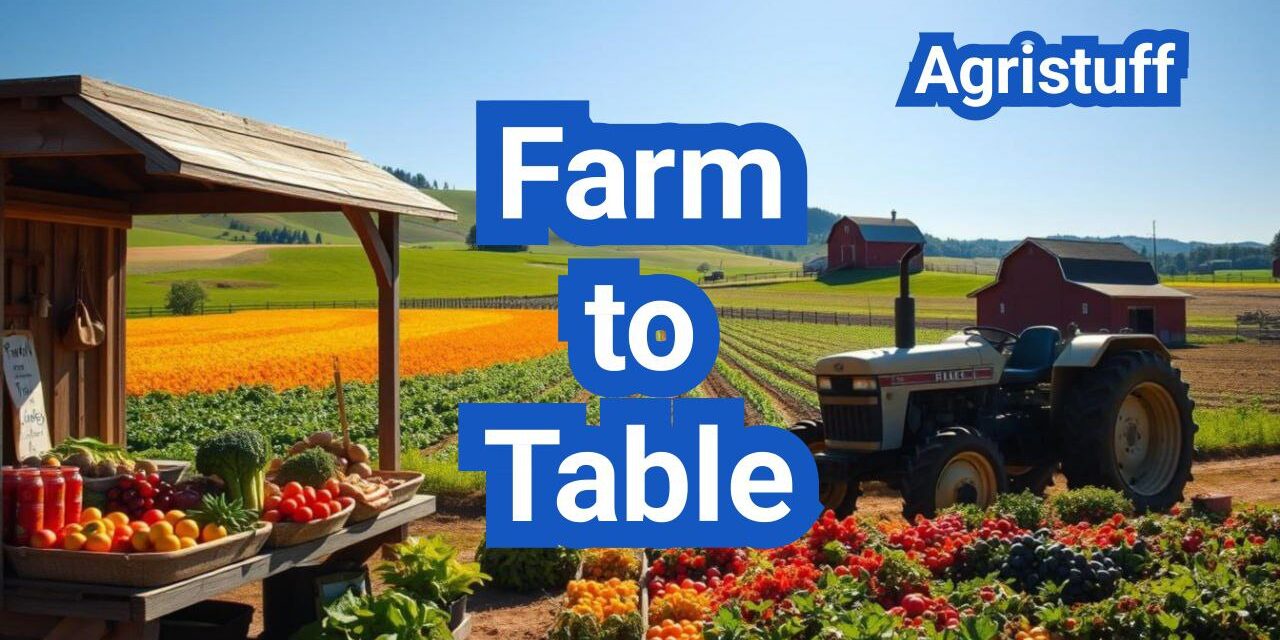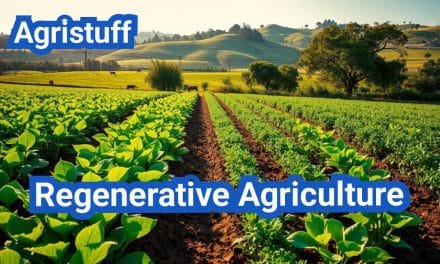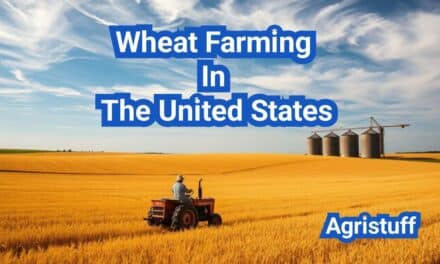The farm to table movement is gaining momentum in America, with consumers increasingly seeking fresh, locally sourced produce. This movement is not just about food; it’s about supporting local economies and reducing environmental impact.
As consumers become more aware of the origin of their food, the demand for locally sourced ingredients is on the rise. The farm-to-table concept emphasizes direct acquisition from producers, promoting a more sustainable food system.
In the United States, this movement is driving growth in community supported agriculture and local food systems, fostering a stronger connection between consumers and producers.
Key Takeaways
- The farm-to-table movement promotes locally sourced food and supports local economies.
- Consumers are driving demand for fresh, locally grown produce.
- Local food systems and community supported agriculture are on the rise.
- The movement reduces environmental impact by minimizing transportation and promoting sustainable practices.
- Farm-to-table emphasizes direct acquisition from producers, fostering a more sustainable food system.
Understanding the Farm to Table Movement
At its core, the farm-to-table movement is about reconnecting consumers with the food they eat and the farmers who produce it. This movement emphasizes the importance of local food systems and community supported agriculture (CSA), promoting a more direct and transparent food supply chain.
What Farm to Table Really Means
The term “farm-to-table” refers to the practice of producing and consuming food locally, reducing the distance between the farm and the consumer’s table. This concept encompasses a wide range of practices, from community supported agriculture (CSA) programs to farmers’ markets and farm-to-table restaurants. The essence of farm-to-table is about creating a more personal and direct relationship between farmers and consumers.
As noted by Alice Waters, a pioneer of the farm-to-table movement, “The most important thing about food is where it comes from, and the most important thing about where it comes from is the people and the land that produce it.” This quote encapsulates the philosophy behind farm-to-table, highlighting the importance of origin, community, and sustainability.
“The most important thing about food is where it comes from, and the most important thing about where it comes from is the people and the land that produce it.” – Alice Waters
Key Principles and Philosophy
The farm-to-table movement is guided by several key principles, including sustainability, seasonality, and community involvement. It advocates for local food systems that support local economies and promote environmental stewardship. By focusing on seasonal produce, farm-to-table encourages a more varied and nutritious diet, while also reducing the carbon footprint associated with long-distance food transportation.
- Emphasis on local and seasonal produce
- Support for local farmers and economies
- Promotion of sustainable agricultural practices
- Encouragement of community involvement through farmers’ markets and CSA programs
Farm to Fork: The Complete Food Journey
The journey from farm to fork is about more than just the physical transportation of food; it’s about understanding the entire food system, from production to consumption. This includes appreciating the labor, care, and resources that go into producing the food we eat. By embracing the farm-to-fork philosophy, consumers can make more informed choices about their food, supporting practices that are beneficial for both their health and the environment.
The farm-to-fork approach also involves a deeper appreciation for the farm to table meaning, recognizing that the value of food extends beyond its taste and nutritional value to include its cultural, social, and environmental significance.
The Evolution of Farm to Table in America

The concept of farm-to-table has been evolving in America since the 1960s, driven by consumer dissatisfaction with industrialized food systems. This movement towards locally sourced and sustainable food has its roots in the counterculture of the 1960s and 1970s.
Historical Roots and Development
The farm-to-table movement gained momentum as Americans began seeking alternatives to processed and mass-produced foods. The rise of organic farming and the emphasis on local food systems were key factors in this development. By the 1970s, the movement had started to take shape, with pioneers emerging to champion the cause.
Pioneers of the Movement
Alice Waters, founder of Chez Panisse, is often credited as a pioneer of the farm-to-table movement. Opening her restaurant in 1971 in Berkeley, California, Waters emphasized the use of fresh, locally sourced ingredients. Chez Panisse became a model for farm-to-table cuisine, influencing other restaurants and consumers alike. Waters’ commitment to sustainable agriculture and local food sourcing helped shape the movement’s philosophy.
Growth Trends and Statistics
Over the years, the farm-to-table movement has experienced significant growth. According to recent trends, there has been a notable increase in consumer demand for locally sourced food. This growth is reflected in the rising number of farmers’ markets and community-supported agriculture (CSA) programs across the United States. Statistics show that the local food market has been expanding, with more consumers willing to pay a premium for fresh, locally sourced produce.
The evolution of farm-to-table in America is a testament to changing consumer preferences and the growing awareness of the importance of sustainable agriculture. As the movement continues to grow, it is likely to have a lasting impact on the way Americans produce, consume, and think about food.
Benefits of Embracing Farm to Table
Embracing farm-to-table practices can have a profound impact on both the environment and local communities. By choosing locally sourced produce, consumers can contribute to a more sustainable food system.
Environmental Sustainability
The farm-to-table movement promotes environmental sustainability by reducing the carbon footprint associated with transporting food over long distances. Locally sourced food requires less packaging and preservation, further minimizing its environmental impact.
- Reduced greenhouse gas emissions from transportation
- Less packaging waste
- Promotion of sustainable farming practices
Economic Impact on Local Communities
Supporting local farmers through the farm-to-table movement has a positive economic impact on local communities. It helps maintain farmland and supports the local economy by keeping financial resources within the community.
- Direct financial support to local farmers
- Job creation in the agricultural sector
- Preservation of farmland and rural landscapes
Health and Nutritional Advantages
Farm-to-table practices often result in fresher, more nutritious food, as produce is harvested at its peak ripeness and consumed shortly after. This approach can lead to improved health outcomes due to higher nutrient intake.
- Increased nutrient content in fresh produce
- Lower risk of pesticide exposure
- Promotion of diverse diets through seasonal eating
Food Quality and Taste Improvement
The emphasis on locally sourced, seasonal ingredients in farm-to-table cuisine typically results in improved food quality and taste. Consumers can enjoy a more varied and flavorful diet by embracing seasonal produce.
Some benefits include:
- Enhanced flavor profiles
- Greater variety in seasonal menus
- Better texture and freshness of ingredients
How Local Food Systems Work

Understanding local food systems is crucial for appreciating the farm to table movement. Local food systems involve the production, processing, distribution, and consumption of food within a specific region, promoting a more direct connection between farmers and consumers.
Components of a Local Food System
A local food system comprises various components that work together to bring food from farms to tables. These include farmers who produce the food, processors who handle the initial processing of raw products, distributors who transport the products to markets, and consumers who ultimately purchase and consume the food.
Each component plays a vital role in the functioning of the local food system. For instance, farmers may use sustainable practices to grow crops, while processors ensure that the produce is handled and prepared for distribution.
Regional Food Economies
Regional food economies are a critical aspect of local food systems. These economies are characterized by the production, processing, and consumption of food within a defined geographic area. By keeping financial transactions within the region, local food economies can boost the local economy and foster community development.
Regional food economies also promote food security by providing a stable source of fresh, locally grown produce. This, in turn, can enhance the overall well-being of the community.
Food Miles and Their Significance
Food miles refer to the distance food travels from the farm to the consumer’s plate. Reducing food miles is a key objective of local food systems, as it minimizes the carbon footprint associated with transportation. By sourcing food locally, consumers can significantly lower the environmental impact of their food choices.
Moreover, shorter food miles often result in fresher, more nutritious produce, as the time between harvesting and consumption is reduced.
Seasonal Availability Patterns
Understanding seasonal availability patterns is essential for making the most of local food systems. Different crops are available at different times of the year, depending on the region’s climate and growing conditions. By embracing seasonal eating, consumers can enjoy a diverse range of fresh produce throughout the year.
Seasonal availability also influences menu planning in farm to table restaurants and home cooking, encouraging creativity and flexibility in the kitchen.
How to Participate in Community Supported Agriculture
The Community Supported Agriculture model allows consumers to purchase shares of a farm’s produce, promoting a direct link between farmers and the community. This approach not only supports local agriculture but also provides consumers with fresh, seasonal produce.
Understanding CSA Shares
CSA shares are essentially subscriptions to a farm’s produce. When you purchase a share, you’re buying a portion of the farm’s output for a specific period, usually a season. This model helps farmers by providing them with upfront capital to cover operational costs.
Key aspects of CSA shares include:
- Variety of produce: Depending on the farm, shares can include a wide range of fruits, vegetables, and sometimes even eggs or dairy products.
- Seasonal availability: The produce included in your share will vary based on what’s in season, encouraging consumers to be flexible and try new foods.
- Distribution methods: CSAs may offer different distribution methods, such as weekly pickups at the farm, delivery to a central location, or even home delivery.
Finding and Joining a CSA
To find a CSA program near you, consider the following steps:
- Research local CSAs: Look for farms in your area that offer CSA programs. You can search online or check local farmers’ markets for information.
- Check the farm’s website: Most farms with CSA programs have a website that outlines their offerings, pricing, and distribution details.
- Ask questions: Before joining, ask about the types of produce included, the size of the shares, and the distribution schedule.
- Sign up: Once you’ve found a CSA that fits your needs, sign up for a share. Be prepared to pay upfront for the season.
By participating in a CSA, consumers can enjoy a variety of benefits, including fresh, locally sourced produce, support for local farmers, and a deeper connection to the food they eat.
Mastering Farmers’ Markets

As a hub for local produce, farmers’ markets play a crucial role in promoting sustainable food practices. They offer a platform where consumers can directly purchase fresh produce from farmers, fostering a sense of community and supporting local economies.
Finding Farmers’ Markets Near You
Locating a nearby farmers’ market is the first step in embracing the farm-to-table lifestyle. Resources such as the USDA’s National Farmers Market Directory can help you find markets in your area. Many local health departments and agricultural extension offices also provide lists of operating farmers’ markets.
Using online directories or mobile apps dedicated to farmers’ markets can simplify the process. Some popular apps allow you to search for markets based on location, operating days, and accepted payment methods, including SNAP benefits.
Shopping Strategies for Maximum Value
To get the most out of your farmers’ market experience, consider arriving early to avoid sold-out items. Bring reusable bags and know the market’s operating rules, such as accepted payment methods. Planning your meals around seasonal produce can also help maximize your shopping value.
Key shopping tips include:
- Buying in bulk to save money and reduce packaging waste
- Asking vendors about their farming practices and the origin of their produce
- Tasting before you buy to ensure quality and freshness
Building Relationships with Vendors
Developing a rapport with farmers’ market vendors can enhance your shopping experience. By showing interest in their products and practices, you can gain insights into the produce and potentially receive recommendations for the best items.
“The beauty of farmers’ markets lies not just in the produce, but in the people who grow it. Building relationships with vendors can turn a simple shopping trip into a meaningful experience.”
— Local Food Advocate
Using SNAP and Nutrition Incentive Programs
Many farmers’ markets now accept SNAP benefits, making fresh, locally grown produce more accessible to a wider audience. Additionally, some markets offer nutrition incentive programs that match SNAP dollars spent on eligible items, effectively doubling the value of your purchase.
| Program | Description | Benefit |
|---|---|---|
| SNAP | Supplemental Nutrition Assistance Program | Assists low-income individuals in purchasing food |
| Nutrition Incentives | Programs that match SNAP spending | Doubles the value of SNAP dollars spent on fresh produce |
By understanding and utilizing these programs, consumers can enjoy a more rewarding farmers’ market experience while supporting local farmers and promoting healthier eating habits.
Dining at Farm to Table Restaurants

Dining at farm-to-table restaurants offers a unique culinary experience that highlights the best of local agriculture. These establishments source their ingredients directly from local farmers, ensuring that the food is fresh and sustainable.
Authenticity Matters
To truly experience the farm-to-table movement, it’s crucial to identify authentic establishments. Here are some key characteristics to look for:
- Locally Sourced Ingredients: Menus that highlight the use of locally sourced produce and meats.
- Seasonal Menus: Menus that change seasonally to reflect the freshest available ingredients.
- Transparency: Restaurants that are open about their sourcing practices and farmers they work with.
Understanding Seasonal Menus
Seasonal menus are a hallmark of farm-to-table restaurants, reflecting the availability of local produce. By changing menus seasonally, these restaurants ensure that dishes are made with the freshest ingredients available.
Some benefits of seasonal menus include:
- Freshness: Ingredients are at their peak flavor and nutritional value.
- Variety: Menus change regularly, offering a new dining experience with each visit.
- Sustainability: Reduces the need for long-distance transportation and storage of ingredients.
Questions to Ask Your Server
To enhance your dining experience, asking the right questions can provide valuable insights into the restaurant’s practices and menu offerings.
- Where do you source your ingredients?
- How often do you change your menu?
- Can you tell me about your favorite dish and why it’s a standout?
Notable Farm to Table Restaurants Across America
Some notable farm-to-table restaurants across America include:
| Restaurant Name | Location | Notable Feature |
|---|---|---|
| The French Laundry | California | Three-Michelin-starred restaurant known for its seasonal tasting menu. |
| Blue Hill | New York | Focuses on using produce from its own farm and local partners. |
| Per Se | New York | Offers a seasonal tasting menu with a focus on local and sustainable ingredients. |
Creating Your Own Farm to Table Kitchen

To bring the farm-to-table concept into your home, you need to focus on seasonal meal planning, smart grocery shopping, and reducing waste. By adopting these practices, you can enjoy a more sustainable and healthy approach to food.
Seasonal Meal Planning
Seasonal meal planning is the cornerstone of a farm-to-table kitchen. It involves planning your meals around what’s available locally during different times of the year. This approach ensures that you’re consuming fresh, flavorful produce while supporting local farmers.
- Research local seasonal produce charts to understand what’s available.
- Plan your meals around seasonal produce to ensure freshness.
- Keep a flexible meal plan to accommodate changes in seasonal availability.
Smart Farm-to-Table Grocery Shopping
Smart grocery shopping is crucial for maintaining a farm-to-table kitchen. It involves buying directly from local farmers or through community-supported agriculture (CSA) programs.
Tips for Smart Grocery Shopping:
- Visit local farmers’ markets to purchase fresh, seasonal produce.
- Consider joining a CSA program for regular deliveries of fresh produce.
- Shop at local grocery stores that source products from nearby farms.
Preserving Seasonal Produce
Preserving seasonal produce allows you to enjoy your local food year-round. Techniques such as canning, freezing, and dehydrating can help extend the shelf life of your favorite fruits and vegetables.
Popular Methods for Preserving Produce:
- Canning: Great for high-acid foods like tomatoes and fruits.
- Freezing: Ideal for preserving the nutritional value of vegetables.
- Dehydrating: Perfect for making dried fruits, herbs, and vegetable snacks.
Reducing Food Waste at Home
Reducing food waste is an essential aspect of a farm-to-table kitchen. It involves being mindful of the food you buy and using up as much of it as possible.
Strategies for Reducing Food Waste:
- Plan your meals carefully to avoid buying too much food.
- Use up leftovers creatively in new meals.
- Compost food scraps to create nutrient-rich soil for your garden.
Navigating Food Hubs and Direct-to-Consumer Sales

Direct-to-consumer sales are on the rise, thanks to the growth of local food hubs and online marketplaces. This shift is transforming the agricultural landscape, providing new opportunities for both farmers and consumers.
How Local Food Hubs Connect Farmers and Consumers
Local food hubs play a crucial role in connecting farmers with consumers. These hubs aggregate produce from multiple farmers, making it easier for consumers to access a variety of locally grown products. By streamlining the distribution process, local food hubs reduce logistical challenges for farmers and improve the availability of fresh produce for consumers.
Key benefits of local food hubs include:
- Increased market access for small and medium-sized farmers
- Improved efficiency in the distribution of locally grown produce
- Enhanced transparency in the food supply chain
Online Marketplaces for Local Food
Online marketplaces have emerged as a significant platform for direct-to-consumer sales. These digital platforms allow consumers to browse and purchase products from local farmers, often with the option for home delivery or farm pickup. Online marketplaces are particularly beneficial for consumers who may not have easy access to physical farmers’ markets or farm stands.
The advantages of online marketplaces include:
- Convenience for consumers to shop from home
- Increased visibility for local farmers and their products
- Opportunities for farmers to reach a broader customer base
Farm Stands and U-Pick Operations
Farm stands and U-pick operations offer consumers a direct connection to the source of their food. These on-farm sales allow consumers to purchase fresh produce directly from the farmers who grew it. U-pick operations, in particular, provide an interactive experience, allowing consumers to pick their own fruits and vegetables.
Benefits of farm stands and U-pick operations include:
- Freshness and quality of produce
- Educational opportunities for consumers to learn about farming practices
- Community building through direct interactions between farmers and consumers
Understanding Farm to Table Certifications and Standards

To make informed choices about their food, consumers need to understand the various certifications and standards associated with farm-to-table produce. These certifications ensure that the produce meets certain criteria for sustainability, safety, and quality.
USDA Organic Certification | Farm to Table
The USDA Organic certification is one of the most recognized standards for organic produce in the United States. To qualify, farms must adhere to strict guidelines that prohibit the use of synthetic fertilizers, pesticides, and genetically modified organisms (GMOs). This certification process involves rigorous inspections and record-keeping to ensure compliance.
Some key benefits of USDA Organic certification include:
- Promoting ecological balance and conserving biodiversity
- Enhancing soil quality through natural methods
- Reducing the exposure to toxic chemicals for consumers and farm workers
Good Agricultural Practices (GAP) | Farm to Table
Good Agricultural Practices (GAP) refer to a set of principles and practices that promote sustainable agriculture and reduce the risk of foodborne illnesses. GAP certification involves audits and inspections to ensure that farms are following safe and sanitary practices.
GAP certification covers various aspects, including:
- Water quality and usage
- Soil management and conservation
- Worker hygiene and safety
- Proper handling and storage of produce
Food Traceability Systems | Farm to Table
Food Traceability Systems are designed to track the movement of food products through the supply chain, from farm to table. These systems are crucial for quickly identifying and recalling contaminated produce in the event of a food safety issue.
Effective food traceability involves:
- Labeling produce with unique identifiers
- Maintaining detailed records of transactions and shipments
- Implementing technology, such as barcode scanning, to streamline tracking
Produce Safety Rule Compliance | Farm to Table
The Produce Safety Rule, part of the FDA’s Food Safety Modernization Act (FSMA), sets standards for the safe growing, harvesting, packing, and holding of produce. Compliance with this rule is mandatory for most produce farms.
Key aspects of Produce Safety Rule compliance include:
| Aspect | Description |
|---|---|
| Water Testing | Regular testing of water used in farming operations |
| Worker Training | Training workers on hygiene and safety practices |
| Soil Amendments | Safe handling and application of soil amendments |
By understanding and adhering to these certifications and standards, consumers and farmers can work together to ensure a safer and more sustainable food system.
Overcoming Common Farm to Table Challenges

Embracing farm-to-table living requires overcoming common hurdles such as seasonal limitations and cost concerns. By understanding these challenges and implementing effective strategies, consumers can enjoy the benefits of local, sustainable food year-round.
Dealing with Seasonal Limitations | Farm to Table
One of the primary challenges of farm-to-table is dealing with seasonal limitations. The availability of certain produce varies throughout the year, depending on the region and climate. To overcome this, consumers can:
- Focus on seasonal produce
- Preserve food through canning, freezing, or dehydrating
- Explore alternative sources like greenhouse-grown produce
Managing Cost Concerns | Farm to Table
The perception that farm-to-table is expensive can be a deterrent. However, there are ways to manage costs:
| Strategy | Description | Potential Savings |
|---|---|---|
| Buying in bulk | Purchasing items like grains, nuts, and dried fruits in larger quantities | Up to 20% |
| Preserving seasonal produce | Canning, freezing, or dehydrating fruits and vegetables when they’re in season | Up to 30% |
| Community Supported Agriculture (CSA) programs | Joining a CSA to receive regular deliveries of fresh, local produce | Varies by program |
Finding Time for Local Food Sourcing
Finding time to source local food can be challenging, especially for those with busy schedules. Strategies include:
- Meal planning around seasonal produce
- Utilizing online platforms for ordering local food
- Visiting farmers’ markets during off-peak hours
Maintaining Commitment Year-Round
To maintain commitment to farm-to-table practices, consumers should:
- Stay informed about local food availability and production methods
- Continuously explore new recipes and meal ideas
- Engage with local farming communities and events
By adopting these strategies, individuals can overcome common farm-to-table challenges and enjoy a more sustainable, local food system.
Debunking Farm to Table Misconceptions

Despite its popularity, the farm-to-table movement is often misunderstood due to prevalent misconceptions. As consumers become more interested in where their food comes from, it’s essential to clarify the realities behind these myths.
All Local Food is Organic | Farm to Table
One common misconception is that all local food is organic. While many local farms use organic practices, not all of them are certified organic. The term “local” refers to the geographical origin of the produce, not the farming methods used.
Certification vs. Practice: Some local farms may adopt organic practices but choose not to undergo the costly and time-consuming certification process.
Farm to Table is Always More Expensive
Another myth is that farm-to-table produce is always more expensive. While some local, specialty, or organic products can be pricier, many farm-to-table options are competitively priced with their supermarket counterparts.
| Produce | Supermarket Price | Farmers’ Market Price |
|---|---|---|
| Apples (per pound) | $1.50 | $1.20 |
| Carrots (per bunch) | $2.00 | $1.80 |
| Eggs (per dozen) | $2.50 | $2.20 |
Local Food is Always Better for the Environment | Farm to Table
The assumption that local food is always more environmentally friendly is another misconception. While local food typically has a lower carbon footprint due to reduced transportation, the overall environmental impact depends on farming practices, water usage, and more.
Sustainable Practices: Local farms that use sustainable practices can have a lower environmental impact, but this isn’t universal.
Availability and Convenience Myths | Farm to Table
Some believe that farm-to-table produce is always limited in availability and inconvenient to access. However, many communities have robust farmers’ markets and CSA programs that make local food accessible.
Increasing Accessibility: Online platforms and local food hubs are also making it easier for consumers to purchase farm-to-table produce.
The Future of Farm to Table in America
The future of farm to table in America is bright, driven by growing consumer interest in local, sustainable food. As the movement continues to evolve, it is likely to have a lasting impact on the way Americans eat and interact with their food.
Local food systems are becoming increasingly important, with consumers prioritizing freshness, sustainability, and community support. This shift is driving the demand for farm to table practices, promoting a more sustainable food culture.
As sustainability becomes a key consideration for consumers, the farm to table movement is poised to play a significant role in shaping the future of American food culture. By supporting local farmers and promoting environmentally friendly practices, consumers can contribute to a more sustainable food system.
The continued growth of the farm to table movement will depend on the ability of local food systems to adapt to changing consumer demands and environmental challenges. With its focus on sustainability and community support, the future of farm to table in America looks promising.
FAQ
What does farm-to-table really mean?
Farm-to-table refers to a culinary movement that emphasizes serving locally sourced, fresh, and seasonal ingredients. It’s about creating a direct link between farmers and consumers, promoting transparency, trust, and sustainability.
When did the farm-to-table movement originate?
The farm-to-table movement gained momentum in the 1960s and 1970s, with pioneers like Alice Waters opening Chez Panisse, a restaurant that became synonymous with farm-to-table cuisine.
What are the benefits of farm-to-table for consumers?
The benefits of farm-to-table for consumers include fresher produce, enhanced nutrition, and the opportunity to support local economies. It also promotes a healthier and more sustainable food system.
What are the benefits of farm-to-table for farmers and local economies?
Farm-to-table benefits farmers and local economies by providing a direct market for their produce, increasing their income, and promoting local economic growth.
Is farm-to-table food more expensive?
Not always. While some farm-to-table products may be more expensive due to the high quality and care taken in their production, many consumers find that the benefits outweigh the costs. Additionally, some farm-to-table options, like seasonal produce, can be more affordable.
Does farm-to-table mean organic?
Not necessarily. While many farm-to-table producers use organic practices, farm-to-table simply means that the food is sourced locally and directly from the farm. Look for certifications like USDA Organic to ensure that the produce is grown using organic methods.
How do restaurants find local suppliers?
Restaurants often find local suppliers through farmers’ markets, local food hubs, and direct relationships with farmers. They may also use online platforms and networks to connect with local producers.
Can you practice farm-to-table at home?
Yes, you can practice farm-to-table at home by planning meals seasonally, shopping at farmers’ markets, and preserving seasonal produce. You can also join a Community Supported Agriculture (CSA) program to receive regular deliveries of fresh, locally sourced produce.
Why is farm-to-table better for the environment?
Farm-to-table is better for the environment because it reduces food miles, promotes sustainable agriculture, and supports local food systems. This approach can help minimize the carbon footprint associated with transporting food long distances.
Do farm-to-table menus change seasonally?
Yes, many farm-to-table restaurants change their menus seasonally to reflect the freshest available ingredients. This approach ensures that the food is at its peak flavor and nutritional value.
What is Community Supported Agriculture (CSA)?
Community Supported Agriculture (CSA) is a program where consumers purchase a share of a farm’s produce on a regular basis, typically weekly or bi-weekly. This model provides farmers with a stable income and consumers with fresh, locally sourced produce.
How can I find a local CSA program?
You can find a local CSA program by searching online, checking with local farmers’ markets, or contacting your state’s agricultural department. Many farms also have their own websites and social media channels to promote their CSA programs.
What are the benefits of shopping at farmers’ markets?
Shopping at farmers’ markets provides numerous benefits, including access to fresh, locally sourced produce, the opportunity to build relationships with vendors, and the ability to support local economies.
How can I make the most of shopping at farmers’ markets?
To make the most of shopping at farmers’ markets, plan your shopping trip according to the season, bring cash, and be prepared to ask questions about the produce. You can also use SNAP and nutrition incentive programs to make your shopping more affordable.
Conclusion of: Farm to Table in The U.S.
What “farm to table” means in the U.S.
At its core, farm to table is a way of sourcing and eating that shortens the journey from local farms to your plate, emphasizing transparency, seasonality, and fewer intermediaries so shoppers know who grew their food and how it was produced. Source: USDA AMS – Local & Regional Food Systems
How farm to table actually works
The main farm to table channels are direct-to-consumer (farm stands, CSAs, farmers’ markets), direct-to-retail (restaurants, groceries), and institutional purchasing (schools, hospitals), all designed to reduce distance, handling, and uncertainty about origin. Source: USDA AMS – Local Food Directories
Community Supported Agriculture (CSA)
In a farm to table CSA, households pre-purchase a share of a farm’s harvest and receive weekly boxes of seasonal produce (often with eggs, dairy, or flowers), sharing risk and reward with the grower and learning local seasonality as they cook. Source: Cornell Small Farms – Community Supported Agriculture
Farm to table in restaurants and schools
Restaurants practicing farm to table list partner farms, rotate menus with the seasons, and buy from producers or food hubs, while K–12 Farm to School programs connect cafeterias to local growers and food education for kids. Source: USDA FNS – Farm to School
Is farm to table really growing?
Public data show farm to table channels expanding from weekend markets to groceries and institutions, diversifying farm income and embedding local food in mainstream supply chains across the U.S. Source: USDA ERS – Local Foods Topic
Food hubs and regional logistics
Many farm to table networks rely on food hubs—regional aggregators that coordinate pickups, cold storage, and deliveries for multiple farms—so restaurants, schools, and groceries can access consistent, traceable supply. Source: USDA AMS – Regional Food Business Centers
Freshness, nutrition, and quality
One draw of farm to table is freshness: careful harvest timing, cooling, and handling help retain flavor and nutrients, which is why many local growers invest in cold-chain basics like shade, ice, and proper storage. Source: UC Davis Postharvest Center – Produce Facts
Nutrition incentives that boost access
Effective farm to table programs pair supply with affordability; the Gus Schumacher Nutrition Incentive Program (GusNIP) matches fruit and vegetable purchases to stretch household budgets while supporting local growers. Source: USDA NIFA – GusNIP
SNAP and farmers’ markets
Access matters in farm to table systems, and many markets accept Supplemental Nutrition Assistance Program (SNAP) benefits, helping families buy fresh produce directly from local farmers with EBT cards. Source: USDA FNS – SNAP Retailer Locator
Local economies and farm resilience
By keeping purchases close to home, farm to table supports diversified farm revenue, strengthens regional supply chains, and builds relationships that can adapt more quickly than long global routes when disruptions occur. Source: USDA ERS – Local Foods Topic
Environment: food miles vs. diet choice
While farm to table often lowers transport and packaging, research shows what we eat (e.g., more plant-forward choices) influences climate impact more than distance alone—though shorter chains can still reduce waste and spoilage. Source: Our World in Data – Food Transport & Emissions
Packaging and waste reduction
Because farm to table favors direct handoffs and reusable containers, it can cut packaging compared with heavily processed, long-haul goods, aligning with national goals to reduce container and packaging waste. Source: EPA – Containers & Packaging Facts
Food safety on the farm
Sound farm to table systems rely on safe growing and handling; the FSMA Produce Safety Rule sets science-based standards for water, soil amendments, worker hygiene, and packing/holding of fresh produce. Source: FDA – FSMA Produce Safety Rule
Food safety in kitchens and retail
Restaurants and retailers in farm to table supply chains follow the FDA Food Code (adopted by state/local health departments) for time/temperature control, sanitation, and allergen awareness to protect diners. Source: FDA – Food Code
Certifications you’ll see
Certification isn’t required for farm to table, but USDA Organic is common; it signals federally verified practices and recordkeeping, and shoppers can learn what the label means before buying. Source: USDA AMS – Organic Basics
Verifying organic and other claims
To avoid greenwashing in farm to table marketing, confirm organic status and standards through the National Organic Program, and expect transparent naming of partner farms on menus and retail signage. Source: USDA – National Organic Program
Finding real farm to table near you
Whether you’re a home cook or chef, use official directories to locate markets and producers, compare hours, and see accepted payments as you build your farm to table routine. Source: USDA AMS – Local Food Directories
Traceability and recall readiness
Modern farm to table depends on good records; the FDA’s Food Traceability Rule requires additional records for certain high-risk foods so any problem can be quickly isolated without penalizing all local suppliers. Source: FDA – Food Traceability Rule
For farmers entering direct markets
Producers expanding into farm to table channels often complete voluntary Good Agricultural Practices (GAP) audits, which reassure buyers on safety and can open doors to institutions and large retailers. Source: USDA AMS – GAP/GHP Audits
Pricing, seasonality, and menu planning
Chefs and households thriving with farm to table lean into seasons, plan menus around peak harvests, and use guides that show when fruits and vegetables are abundant and most budget-friendly. Source: USDA FNS – Seasonal Produce Guide
Rural and urban access
Equitable farm to table growth means addressing food access; data tools help communities see neighborhoods with limited grocery options and tailor local food strategies accordingly. Source: USDA ERS – Food Access Research Atlas
Grocery retailers and local sourcing
Beyond restaurants, farm to table shows up in neighborhood supermarkets and co-ops where buyers cultivate regional supplier lists and highlight state-grown products with shelf tags and seasonal displays. Source: USDA AMS – Local & Regional Food Systems
Getting started this week
The easiest entry into farm to table is to try one seasonal swap (local eggs or greens), visit a market to ask vendors what’s best right now, and pick one restaurant that names its farm partners on the menu. Source: USDA AMS – Farmers Market Directory
Final thought
Ultimately, farm to table is not just a culinary trend—it’s a practical way to strengthen flavor, community, and resilience by bringing producers and eaters closer together through transparent, seasonal, and safe supply chains. Source: USDA ERS – Local Foods Topic
Sources & References
- USDA AMS – Local & Regional Food Systems
- USDA FNS – Farm to School
- USDA ERS – Local Foods Topic
- USDA NIFA – GusNIP
- USDA FNS – SNAP Retailer Locator
- Our World in Data – Food Transport & Emissions
- EPA – Containers & Packaging Facts
- FDA – FSMA Produce Safety Rule
- FDA – Food Traceability Rule
- USDA AMS – GAP/GHP Audits
- USDA FNS – Seasonal Produce Guide
- USDA ERS – Food Access Research Atlas
- USDA AMS – Farmers Market Directory










